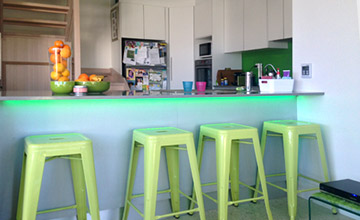


LEDs can be used to build energy-efficient lighting products that save energy, help protect the environment, reduce maintenance costs and make people and things look much more attractive than traditional lighting. They also last much longer than traditional lighting.
Benefits: LED’s come in all types of globes and fittings, so you can keep your period looking lights and still save money.
LED lighting can save you up to 85 percent of the electricity used by incandescent bulbs and up to 50 percent of electricity used by fluorescents.
Benefits: This means you will be able to save quicker for your next holiday, not just this year but the next 5 years.
Since LED lights are so energy-efficient, the most common applications are places where lights are switched on for an extended period of time. You can find LED lights in restaurants, offices, parking lots, streetlights, dorm rooms, ice skating rinks and, of course, in homes. You can see some places that have installed LED lights here.
Benefits: You can have the experience of LED’s absolutely everywhere without compromise.
Most of the energy emitted from incandescent bulbs is converted to heat instead of light. That’s why you’ll burn yourself if you try to touch an incandescent bulb once it’s turned on.
Benefits: Children won’t be able to injure themselves on hot surfaces and the hot glass will not explode if broken, while the little mites are playing!
LEDs don’t contain hazardous materials, such as mercury. Since fluorescent tubes and CFLs contain mercury, they must be properly disposed of in order to prevent mercury from poisoning landfills. Also, most fluorescent lights cannot be dimmed and many can flicker. Some people are sensitive to this flicker and experience headaches, migraines and eye strain.
Benefits: LED's do not contain any of these toxic elements, so are safer to have around your place protecting you and the environment! LED lighting uses solid-state technology, which allows effective dimming in many applications and eliminates flickering.
You should be satisfied with the light quality coming from any light—LED or otherwise. The best way to ensure this is to know what colour light you want and how to ask for it. If you want warm light, look for lighting that is close to 3000K. If you want a more neutral or cool light, look for something closer to 5000K and if you want a day light, look for 6500K or more. But that’s not all… you also need to be aware of colour rendering. The ability to make colours look true – that is to have a tomato look like a tomato – is called colour rendering. The colour rendering index (CRI) characterises light sources in view of their ability to produce 'natural light' and can be between 0 and 100. The closer an LED light comes to 100 on CRI, the more naturally colours are rendered, and the light is perceived as more pleasant.
Benefits: The CRI of fluorescent tubes is often around 72. Cree LED lighting fixtures have a CRI of between 85 and 95. This is great for cooking, so you can see the true colour of your rich food and is perfect for reading environments for children, who enjoy seeing pictures with bright colours.
With the right design, LED lights can have a lifetime of 50,000 hours and more in continuous operation. Depending on how many hours-a-day they are operating, that can be from 6 to 7 years, to as many as 20 to 30 years.
Benefits: No more going out to the supermarket to buy the wrong type of globe because there are so many out there, then having to go back to replace it. Or you just put them in a cupboard until you have so many, you feel like a hoarder! No more getting up and down steps to replace globes every few weeks.
Is it purely the up-front cost of a light, or do you factor in the cost of the energy to run that light? If you’re a business or government, what is the cost to change the lightbulb? If you’re building a new building, installing LED lighting is often just about the same cost as traditional technology—and you’ll start saving money through reduced energy consumption, the minute you flip the switch.
Benefits: This means you will be immediately receiving all the benefits mentioned above when you change over to LED’s. The money and energy you save, means an LED light will pay itself off within 18 months. The more it's used, the quicker the pay back.
Don’t think of it as a cost but more an investment, which you will get a return on as soon as you switch it on!